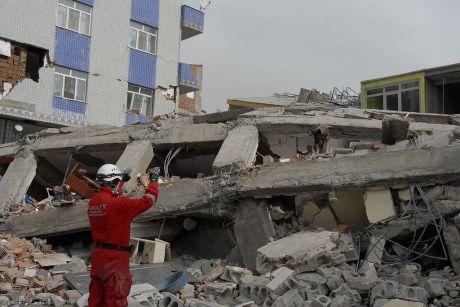Quantifying uncertainty in seismic structural models

AKUT 2011 Van 2
By AKUT Search and Rescue Association (AKUT Search and Rescue Association) [CC BY-SA 3.0 (http://creativecommons.org/licenses/by-sa/3.0)], via Wikimedia Commons
Mathematical models that predict the structural stability of buildings during earthquakes are critical to better designs and earthquake management. New methods to more accurately evaluate inherent uncertainties in models will aid engineers and policymakers.
Engineers expect an inelastic response of buildings to an earthquake,
meaning that the buildings absorb part of the seismic energy through
irreversible. In most cases, it remains difficult to establish
confidence levels in numerical prediction of the inelastic seismic
response. This is due to both the inherent uncertainty associated with
the physical systems and lack of knowledge about the irreversible
mechanisms actually activated during the earthquake.
The EU-funded NOUS (Probabilistic inverse models for assessing the predictive accuracy of inelastic seismic numerical analyses) project takes an innovative approach based in probabilistic inverse theory to evaluate the modeling uncertainty associated with inelastic seismic numerical analyses. In the inverse problem, data from indirect observations or from techniques such as Monte Carlo simulations can be used to estimate unknown parameters of physical systems.
Researchers have developed a probabilistic non-linear structural model of a reinforced concrete frame structure tested on a shaking table. Probability distributions represent the uncertainties associated with the model parameters and outputs.
Fundamental to the uncertainty analysis are the damping forces, or discrepancy forces, introduced to the inelastic seismic numerical analyses to ensure that the simulation accurately predicts experimentally observed data. The NOUS project assumes that these discrepancy forces reflect the uncertainty of the model.
Scientists used Markov Chain Monte Carlo simulations (in which numerous trials are run using a variety of inputs) to determine the model parameters leading to the smallest discrepancy forces, hence solving the probabilistic inverse problem.
The discrepancy forces thus computed will be used to measure the model's uncertainty. Additional models based on stochastic multi-scale numerical methods are simulating material damping to gain further insight into the physics of damping.
NOUS tools will enable assessment of the predictive accuracy of numerical models used to simulate the response of non-linear structures in regions prone to seismic activity. They will improve seismic risk management methods. These will have impact on engineers designing or retrofitting buildings, insurance companies developing policies and crisis teams seeking to save lives during seismic events.
published: 2015-10-21

